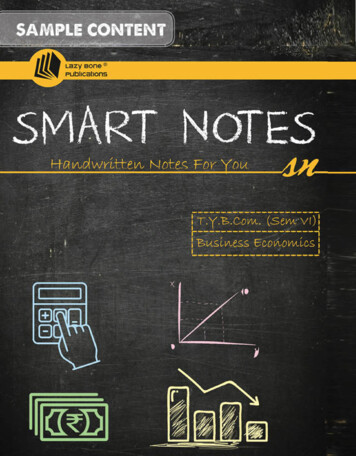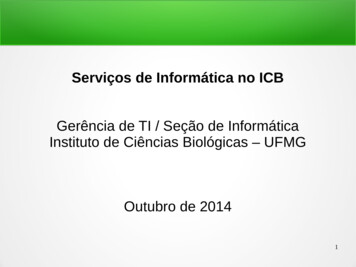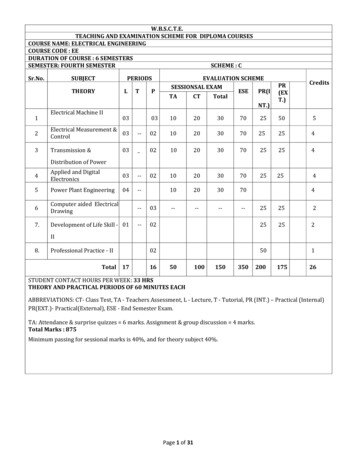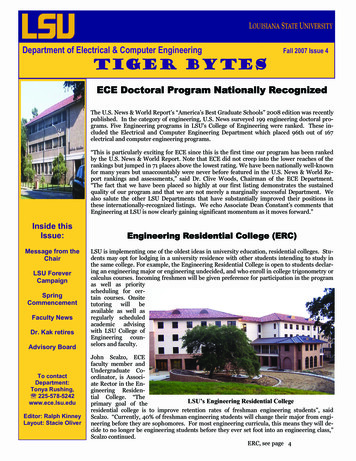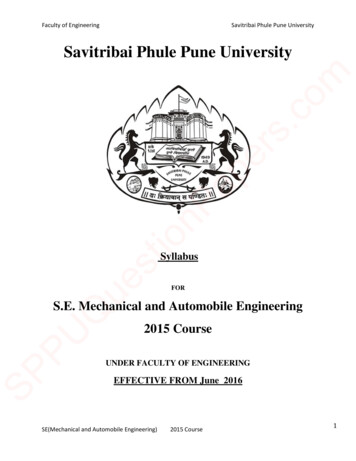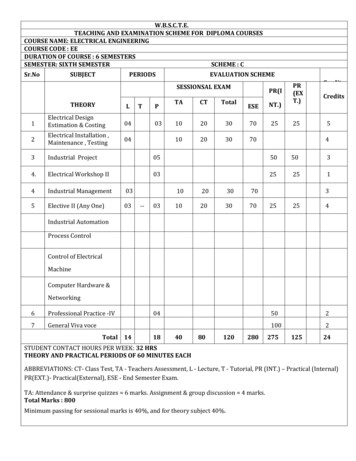
Transcription
W.B.S.C.T.E.TEACHING AND EXAMINATION SCHEME FOR DIPLOMA COURSESCOURSE NAME: ELECTRICAL ENGINEERINGCOURSE CODE : EEDURATION OF COURSE : 6 SEMESTERSSEMESTER: SIXTH SEMESTERSCHEME : CSr.NoSUBJECTPERIODSEVALUATION SCHEMESESSIONSAL 0PR(EXT.)CreditsCreditsCredits51Electrical DesignEstimation & Costing042Electrical Installation ,Maintenance , Testing043Industrial Project05505034.Electrical Workshop II03252514Industrial Management035Elective II (Any One)0303--031020307010203070254325254Industrial AutomationProcess ControlControl of ElectricalMachineComputer Hardware &Networking6Professional Practice -IV7General Viva voceTotal 1404184080120280502100227512524STUDENT CONTACT HOURS PER WEEK: 32 HRSTHEORY AND PRACTICAL PERIODS OF 60 MINUTES EACHABBREVIATIONS: CT- Class Test, TA - Teachers Assessment, L - Lecture, T - Tutorial, PR (INT.) – Practical (Internal)PR(EXT.)- Practical(External), ESE - End Semester Exam.TA: Attendance & surprise quizzes 6 marks. Assignment & group discussion 4 marks.Total Marks : 800Minimum passing for sessional marks is 40%, and for theory subject 40%.
West Bengal State Council of Technical Education(A Statutory Body under West Bengal Act XXI of 1995)Kolkata Karigori Bhavan, 2nd Floor, 110 S. N. Banerjee Road, Kolkata - 700 013.Name of the Subject: Electrical Design, Estimation & CostingSubject Code: EE/S6/EDECSemester: S6Duration: one SemesterMaximum Marks: 150Teaching SchemeExamination SchemeTheory:4 Hrs/WeekMid Semester Exam.: 20MarksTutorial:Assignment & Quiz:10MarksPractical: 3 Hrs/weekEnd Semester Exam.: 70MarksCredit:5Practical: 50MarksAim:Sl. No.Electrical Diploma holders have to work as Technicians & Supervisors for Electrical1.Installations of various companies, commercial and Industrial electrification schemes andprepares estimates for these schemes.Knowledge of electrical engineering drawing, IE rules, NEC, different types of electrical2.Installation their design considerations equips the students with the capability to design andprepare working drawing of different Installation projects.3.Understanding of the methods and procedure of estimating the material is also requiredObjective:Sl. No. Student will be able to:1.State IE rules, NEC related to Electrical Installation and testing2.Interpret the Electrical Engineering DrawingState and describe the basic terms, general rules, circuit design procedure, wiring design and3.design considerations of Residential Electrical Installations,Explain the sequence to be followed in carrying out the estimate of Residential Electrical4.Installations.5.Design of main dimensions of rotating machines.6.Design of core and winding of a 3-phase transformer up to 200KVA7.Understand the concept of contracts, contractors, tender and tender document and itsrelated procedures.Pre-Requisite:Sl. No.Basic Electrical Engineering1.Engineering Graphics2.Contents (Theory)Unit: 1Standard Norms and Specifications:Importance of Design-Estimation-Costing ofelectrical equipments & installations, Concept of I.E.Rules, Importance of Standards & Specifications forelectrical installation and equipments.Indian Electricity Rules (1956):Rule 28 : Voltage level definitions.Rule 30: Service lines & apparatus on consumerHrs./Unit Marks0406
premises.Rule 31: Cut-out on consumer’s premises.Rule46: Periodical inspection & testing ofconsumer’s installation.Rule 47: Testing of consumer’s installation.Rule 54: Declared voltage of supply to consumer.Rule 55: Declared frequency of supply to consumer.Rule 56: Sealing of meters & cut-outs.Rule 77: Clearances above ground of the lowestconductor.Rule 79: Clearances between conductors & trolleywires.Rule 87: Lines crossing or approaching each other.Rule 88: Guarding.Unit: 2Design of Lighting circuits:04Illumination level required for various applications,Factors considered for good lighting design,Determination of number of lamps & selection oflamp type, Design for placement of lamps in a roomfor proper & uniform illumination. (Numerical)06Unit: 3Service Connection3.1 Concept of service connection.3.2 Types of service connection & their features.3.3 Methods of Installation of service connection.3.4 Estimation of under ground & overheaddomestic service connections. (Numerical)Residential Building Electrification4.1 General rules guidelines for wiring ofResidential Installation and positioning ofequipments.4.2 Principles of circuit design in lighting andpower circuits.4.3 Procedures for designing the circuits anddeciding the number of sub- circuits.4.4 Method of drawing single line diagram &wiring diagram4.5 Selection of type of wiring and rating of wires &cables.4.6 Selection of rating of main switch, distributionsboard, protective switchgear ELCB, MCB and wiringaccessories.4.7 Earthing of Residential Installation.4.8 Sequence to be followed for preparingEstimation of wiring.4.9 Preparation of detailed estimates and costing asper PWD schedule of electrification of ResidentialInstallation.(Numerical)Electrification of commercial Installation5.1 Concept of commercial Installation.5.2 Differentiate between electrification ofResidential and commercial Installation (shopping060810101212Unit: 4Unit: 5
Unit: 6Unit: 7mall, Office complex)5.3 Fundamental considerations for planning of anelectrical Installation system for shoppingmall/office complex.5.4 Design considerations of electrical Installationsystem for air conditioned shopping mall/officecomplex.5.4.1 Load calculations & selection of accessories forconnection.5.4.2 Deciding the size of cables, busbar and busbarchambers.5.4.3 Mounting arrangements and positioning ofswitchboards, distribution boards main switch etc.5.4.4 Earthing of the electrical Installation5.5 Selection of type wiring system & layout.5.6 Sequence to be followed to estimate of wiring.5.7 Preparation of detailed estimate and costing asper PWD schedule of electrification of shoppingmall/office complex.Electrification of factory unit Installation6.1 Important guidelines about power wiring andMotor wiring.6.2 Design consideration of Electrical Installationin small Industry/Factory/workshop.6.2.1. Motor current calculations.6.2.2. Selection and rating of wire, cable size.6.2.3 Deciding fuse rating, starter, distributionboards main switch etc.6.2.4. Deciding the cable route, determination oflength of wire, cable, conduit, earth wire, andearthing.6.3 Sequence to be followed to prepare estimate.6.4 Preparations of detailed estimate and costingas per present market rate of small factoryunit/workshop.Design of Electrical Transformer:101010100808a) Single phase transformer up to 1 KVACore Design, Selection of stamping, winding design,window area calculation. (Numerical)b) 3-phase transformer up to 250 KVA Basicdesignprinciplesandapproaches,Specification, Magnetic circuit, Output equationsand Output Co-efficient, Core construction anddesign, Window design, Winding design, Size oftank, Winding temperature rise, Insulation classes,Cooling methods. (Numericals)Unit: 8Contracts, Tenders and Execution8.1 Concept of contracts and Tenders8.1.1 Contracts, types of contracts, contractors.8.1.2 Valid Contracts, Contract documents.8.1.3 Tender and tender notices.8.1.4 Procedure for submission and opening
tenders.8.1.5 Comparative statements, criteria for selectingcontractors, General conditions in order form.8.2 Principles of Execution of works8.2.1 Administrative approval, Technical sanctions.8.2.2. Billing of executed work.TotalContents (Practical)6470Sl. No.1.Skills to be developedIntellectual Skills: i) Analytical Skillii) Identification skill2.Motor Skills: i) Operate various parts of computer properly.ii) Problem solving skill.Suggested list of Laboratory Experiments:Sl. No. Laboratory Experiments1.A newly constructed workshop is required to be fitted with a 10 H.P. Squirel cage induction motor.I) Draw Installationplan showing location of main control board, motor control board,motor etc, (using CAD)ii) Draw single line wiring diagram. (using CAD)iii) Draw wiring diagram starting from energy meter upto electric motor. (using CAD)2.Draw Single line diagram and layout plan of 11KV indoor Substation (using CAD)3.Draw Sectional Drawing of different types of cables, overhead conductors (using CAD)4.Draw Sectional Drawing of different types of insulators (using CAD)5.Draw Core construction, H.T. & L.T. winding, other accessories of 3 phase transformer (using CAD).6.Draw pole, yoke , field coils, commutator and its details of D.C. Machine (using CAD).7.Draw transmission line structure (using CAD)Text Books:Name of AuthorsTitle of the BookEditionName of the PublisherK.B. RainaElectrical Design; Estimating andNew Age InternationalS.K.Bhattacharyacosting(p) Limited, New DelhiElectricalEstimatingandcostingDhanpat Rai andSurjit Singhcompany, New DelhiJ.B.GuptaA course in Electrical Installation,S.K.Kataria & sonsEstimating & costingElectrical wiring Estimating andS.L. UappalKhanna Publication.costingA.K.SawhneyElectrical Machine DesignDanpat Rai & co.The Electricity Rule 2005N. AlagappanS. EkambaramSurjit SinghElectrical Estimating and costingElectrical Engineering DrawingUniversal Law PublishingCo. Pvt. Ltd.Tata Mc Graw HillPublication, New DelhiS.K.Kataria & Sons
E X A M I N A T I O N S C H E M E (THEORITICAL)GROUPUNITONE OR TWO SENTENCE ANSWERQUESTIONSTO BESETA1, 2,3,4,512B6,7,811TO BEANSWEREDMARKSPERQUESTIONTOTALMARKSSUBJECTIVE QUESTIONSTO BESETFIVETWENTYONE1 X 20 20FOURTO BEANSWEREDFIVE, TAKING ATLEAST TWOFROM EACHGROUPMARKS PERQUESTIONTOTALMARKSTEN10 X 5 50Note: Paper-setter should take into account the marks which have been allotted ineach unit and set the paper accordingly so that all units get the importance as allotted.E X A M I N A T I O N S C H E M E (SESSIONAL)1.Continuous Internal Assessment of 25 marks is to be carried out by the teachers throughout the SixthSemester. Distribution of marks: Performance of Job – 15, Notebook(Drawing Sheet)– 10.2.External Assessment of 25 marks shall be held at the end of the Sixth Semester on the entire Sessionalsyllabus. One Drawing sheet from any one of the above is to be drawn. Distribution of marks: On spot job – 15,Viva-voce – 10.
West Bengal State Council of Technical Education(A Statutory Body under West Bengal Act XXI of 1995)Kolkata Karigori Bhavan, 2nd Floor, 110 S. N. Banerjee Road, Kolkata - 700 013.Name of the Subject : Electrical Installation , Maintenance , TestingSubject Code: EE/S6/EIMTSemester: SIXTHDuration: one SemesterMaximum Marks: 150Teaching SchemeExamination SchemeTheory:4 Hrs/weekMid Semester Exam.:20 MarksTutorial:Assignment & Quiz:10 MarksPractical: 3 Hrs/WeekEnd Semester Exam.:70 MarksCredit:Practical:NILAim:Sl. No.This is technology level subject with application in Industry, commercial, public utility1.departments such as PWD, Electricity Board etc.After studying this subject student will be able to inspect, test, install & commission electrical2.machines as per IS .Objective:Sl. No. The student will be able to: Know safety measures & state safety precautions.1. Test single phase, three phase transformer, DC & AC machine as per IS.2. Identify / Locate common troubles in electrical machines & switch gear.3. Plan & carry out routine & preventive maintenance.4. Install LV switchgear & maintain it.5. Ascertain the condition of insulation & varnishing if necessary.6. Identify faults & measures to repair faults.7.Pre-Requisite:Sl. No.1.Knowledge of electrical equipmentsContents (Theory)Hrs./Unit MarksSafety&PreventionofAccidents:Unit: 105051.1 Definition of terminology used in safety1.2 I.E. Act & statutory regulations for safety of persons & equipmentsworking with electrical installation1.3 Dos & don’ts for substation operators as listed in IS.1.4 Meaning & causes of electrical accidents factors on which severityof shock depends,1.5 Procedure for rescuing the person who has received an electricshock, methods of providing artificial respiration,1.6 Precautions to be taken to avoid fire due to electrical reasons,operation of fire extinguishersGeneral Introduction:Unit: 205052.1 Objectives of testing significance of I.S.S. concept of tolerance,routine tests, type tests, special tests.2.2 Methods of testing a) Direct, b) Indirect, c) Regenerative.2.3 Classification and need of maintenance2.4 Advantages of preventive maintenance, procedure for developing
Unit: 3Unit: 4Unit: 5Unit: 6Unit: 7preventive maintenance schedule,2.5 Factors affecting preventive maintenance schedule.2.6 Introduction to total productive maintenance.Testing & maintenance of rotating machines:3.1 Type tests, routine tests & special tests of 1 & 3 phase Inductionmotors,3.2 Routine, Preventive, & breakdown maintenance of 1 & 3 phaseInduction motors as per IS 9001:19923.3 Parallel operation of alternators, Maintenance schedule ofalternators & synchronous machines as per IS 4884-19683.4 Brake test on DC Series motor.Testing & maintenance of Transformers:4.1Listing type test, routine test & special test as per I.S. 2026-19814.2 Procedure for conducting following tests:Impedance voltage, load losses, Insulation resistance, Induced overvoltage withstand test, Impulse voltage withstand test, Temperaturerise test of oil & winding, Different methods of determining temprise- back to back test, open delta (delta – delta) test.4.3 Preventive maintenance & routine maintenance of distributiontransformer as per I.S. 10028(part III): 1981Testing & maintenance of Insulation:5.1 Classification of insulating materials as per I.S. 8504(part III)1994.5.2 Factors affecting life of insulating materials.5.3 Methods of measuring temperature of internal parts of windings/machines & applying the correction factor when the machine is hot.5.4 Properties of good transformer oil. List the agents whichcontaminates the insulating oil.5.5 Understand the procedure of following tests on oil as per I.S.1692-1978a) acidity test b) sludge test c) crackle test d) flash point test.5.6Filtration of insulating oil5.7 Protection of electrical insulation during the period of inactivity.5.8 Methods of cleaning the insulation covered with loose, dry dust,sticky dirt, & oily viscous films, procedure for cleaning washing &drying of insulation & revarnishing.5.9 Methods of internal heating & vacuum impregnation.Trouble shooting of Electrical Machines & Switch gear:6.1Significance of trouble shooting of various electrical machines anddescribes the procedure for the same.6.2 Various types of faults (mechanical, electrical & magnetic) inelectrical machines and reason for their occurrence.6.3 Use of following tools: Bearing puller, Filler gauge, dial indicator,spirit level, growler.6.4 Trouble shooting charts for Single & 3-phase induction motor,Single & 3- phase transformer.6.5 List the common troubles in HV and LV switchgear, contactors &batteries.Installation:7.1 Inspection procedure of Machine Installation.7.2 Factors involved in designing the machine foundation,7.3 Requirement of different dimension of foundation for static &rotating machines procedure for levelling & alignment of two shaftsof directly & indirectly coupled drives, effects of misalignment.7.4 Installation of rotating machines as per I.S. 900-1992.10101010081008101210
Unit: 87.5 Use of various devices & tools in loading & unloading, lifting,carrying heavy equipment.7.6 Method of drying out of Machines.7.7 Classification of transmission tower7.8 Installation of Transmission Tower (From foundation to completeerection).Earthing:066.1 Introduction & importance.6.2 Step potential & Touch potential.6.3 Factors affecting Earth Resistance.6.4 Methods of earthing6 .5 Substation and Transmission Tower earthing6.6 Transformer Neutral Earthing.Total64Text Books:Name of AuthorsTarlok SibghTitle of the BookInstallation, Commissioning &Maintenance of ElectricalEquipmentOperatin & Maintenance ofElectrical Machines Vol I & IIB.V.S.RaoEdition1070Name of the PublisherS.K.Kataria & SonsMedia Promoters &Publisher Ltd. MumbaiE X A M I N A T I O N S C H E M E (THEORITICAL)GROUPUNITONE OR TWO SENTENCE ANSWERQUESTIONSTO BESETA1, 2,3,4,512B6,7,811TO BEANSWEREDMARKSPERQUESTIONTOTALMARKSSUBJECTIVE QUESTIONSTO BESETFIVETWENTYONE1 X 20 20FOURTO BEANSWEREDFIVE, TAKING ATLEAST TWOFROM EACHGROUPMARKS PERQUESTIONTOTALMARKSTEN10 X 5 50Note: Paper-setter should take into account the marks which have been allotted ineach unit and set the paper accordingly so that all units get the importance as allotted.
West Bengal State Council of Technical Education(A Statutory Body under West Bengal Act XXI of 1995)Kolkata Karigori Bhavan, 2nd Floor, 110 S. N. Banerjee Road, Kolkata - 700 013.Name of the Course: Electrical Workshop IICourse Code: EE/S6/WSIISemester: SIXTHDuration: one SemesterMaximum Marks: 50Teaching SchemeExamination SchemeTheory:Practical :50 MarksTutorial:Practical: 3 hrs./weekCredit: 1 (One)Aim:Sl. No.A technician should carry out routine & preventive maintenance of electrical machines &1.possesses knowledge of Indian Electricity Act, safety rules, safety of machines & persons,prevention of accident. He/She should also able to repair various appliences.Objective:Sl. No. Identify / Locate common troubles in electrical machines & switch gear.1.2. Plan & carry out routine & preventive maintenance.3. Ascertain the condition of insulation & varnishing if necessary.4. Identify faults & measures to repair faults.Pre-Requisite:Sl. No.1.Knowledge of electrical equipments and accessories.Contents (Practical)Suggested list of Practicals/Exercises:Sl. No. Practicals/ExercisesTo Demonstrate various components of D.O.L., Star-Delta and Auto Transformer Starter.1.2.To prepare a report on specifications of earthing at different substations/different locations& new trends in earthing schemes.3.To observe & carry out periodic maintenance of D.C & A.C. motor in your workshop orlaboratories & prepare its report4.To prepare trouble-shooting chart & carry out maintenance of a single and three phasetransformers5.To prepare trouble-shooting chart & carry out maintenance of single and three phaseinduction motors6.To prepare trouble-shooting chart for HV and LV Switch Gear
7.8.To carry out filtration of insulating oil and measure Break Down Voltage.Dismantling, assembly, testing, preparation of list of components, parts for: (any four)i) D.C. compound motorii) 3 phase Induction motor.iii) Geyser.iv) UPS / Inverters / battery chargersv) Microwave Ovensvi) Semi automatic & fully automatic washing machineE X A M I N A T I O N S C H E M E (SESSIONAL)1.Continuous Internal Assessment of 25 marks is to be carried out by the teachers throughout the SixthSemester. Distribution of marks: Performance of Job – 15, Laboratory Notebook – 10.2.External Assessment of 25 marks shall be held at the end of the Sixth Semester on the entire Sessionalsyllabus. One Experiment per student from any one of the above is to be performed. Experiment is to be set bylottery system. Distribution of marks: On spot job – 15, Viva-voce – 10.
West Bengal State Council of Technical Education(A Statutory Body under West Bengal Act XXI of 1995)Kolkata Karigori Bhavan, 2nd Floor, 110 S. N. Banerjee Road, Kolkata - 700 013.Name of the Subject : ELECTRICAL ENGINEERING PROJECTSSubject Code: EE/S6/EEPSemester: SixthDuration: one SemesterMaximum Marks:Teaching SchemeExamination SchemeTheory:Mid Semester Exam.:MarksTutorial:Assignment & Quiz:MarksPractical: 5 hrs/weekEnd Semester Exam.:MarksCredit:03Practical: 100 MarksAim:Sl. No.1.This subject is intended to teach students to understand facts, concepts and techniques ofelectrical equipments, its repairs, fault finding and testing, estimation of cost and procurement ofmaterial, fabrication and manufacturing of various items used in electrical fieldThis will help the students to acquire skills and attitudes so as to discharge the function of2.supervisor in industry and can start his own small-scale enterpriseObjective:Sl. No. Develop leadership qualities.1. Analyze the different types of Case studies.2. Develop Innovative ideas.3. Develop basic technical Skills by hands on experience.4. Write project report.5. Develop skills to use latest technology in Electrical field.6.Pre-Requisite:Sl. No.1.Knowledge of subjects up to 5th Semester of Electrical Engineering2.ContentsThis subject is the continuation of the part of Industrial Project of subject “INDUSTRIAL PROJECT ANDENTREPRENEURSHIP DEVELOPMENT “ studied in 5th Semester. Following activities related to projectare required to be dealt with, during this semester.1 . Each project batch should carry out the actual Project works which have been approved in FifthSemester.2.At the end of this semester each project batch should prepare the detailed project report &submit the same to respective guide.
The list of projects are same as in 5th semester which are as follows:Group1Projects(1) Design of Rural Electrification Scheme for smallVillage, Colony.(2) Energy Conservation and Audit.(3) Substation Model (Scaled)(4) Wind Turbine Model (Scaled)( 5) Pole Mounted Substation Model (Scaled)(6) Conduct load survey to ascertain the totalload requirements of a locality /polytechnic.2(7) Any other items as may be assigned by theteacher concerned.(1) Rewinding of Three Phase/Single PhaseInduction Motor.(2) Rewinding of Single Phase Transformer.(3) Fabrication of Inverter up to 1000 VA.(4) Fabrication of Battery Charger.(5) Fabrication of Small Wind Energy System forBattery Charging.(6) Fabrication of Solar Panel System for BatteryCharging.(7)Fabrication of Water level controller.(8)Fabrication of DC motor speed controlcircuit by SCRs.(9) Microprocessor/ Micro controller BasedProjects.(10) Simulation Projects using Matlab.(11) Any other items as may be assigned by theteacher concerned.Continuous Internal Assessment of 50 marks is to be carried out by the teachers throughout the semesters.Distribution of marks: Project Work – 25, Project Report Presentation – 15, Viva-voce – 10.External assessment of 50 marks shall be held at the end of the Sixth Semester on the entire Project Work.The external examiner is to be from Industry / Engineering College / University / Government Organisation.Distribution of marks: Project Work - 25, Project Report Presentation – 15, Viva-voce – 10.
West Bengal State Council of Technical Education(A Statutory Body under West Bengal Act XXI of 1995)Kolkata Karigori Bhavan, 2nd Floor, 110 S. N. Banerjee Road, Kolkata - 700 013.Name of the Subject : Industrial ManagementSubject Code: EE/S6/IMSemester: SixthDuration: one SemesterMaximum Marks:Teaching SchemeExamination SchemeTheory:3 hrs/weekMid Semester Exam.:20MarksTutorial:Assignment & Quiz:10MarksPractical:End Semester Exam.:70MarksCredit:03Practical:NILMarksAim:Sl. No.To study the techniques for improvement in productivity of the people and equipment. to plan1.the production schedule accordingly organize material supply for the manufacturing activities.To minimize the direct and indirect cost by optimizing the use of resources available. To learnaccounting process, inventory control and process planning. Modern manufacturing systememploy techniques such as JIT, TPM , FMS, 5’S’, kaizen which should be known to thetechnician.Objective:Sl. No. The student will able toFamiliarize environment in the world of work1.Explain the importance of management process in Business.2.Identify various components of management3.Describe Role & Responsibilities of a Technician in an Organizational Structure.4.Apply various rules and regulations concerned with Business & Social Responsibilities5.of the TechnicianPre-Requisite: NILContents (Theory)Hrs./UnitMarksGROUP AOverview Of Business04011.1. Types of BusinessServiceManufacturingTrade1.2. Industrial sectorsIntroduction toEngineering industryProcess industryTextile industryChemical industryAgro industry1.3 GlobalizationIntroductionAdvantages & disadvantages w.r.t. India1.4 Intellectual Property Rights (I.P.R.)Management Process02052.1 What is Management?
0304EvolutionVarious definitionsConcept of managementLevels of managementAdministration & managementScientific management by F.W.Taylor2.2 Principles of Management (14 principles ofHenry Fayol)2.3 Functions of 4 Social responsibility and Environmentaldimension of managementGROUP:BOrganizational Management3.1 Organization :DefinitionSteps in organization3.2 Types of organizationLineLine & staffFunctionalProject3.3 DepartmentationCentralized & DecentralizedAuthority & ResponsibilitySpan of Control3.4 Forms of ownershipPropriotershipPartnershipJoint stockCo-operative SocietyGovt. SectorHuman Resource Management4.1 Personnel s4.2 StaffingIntroduction to HR PlanningRecruitment Procedure4.3 Personnel– Training & DevelopmentTypes of trainingInductionSkill Enhancement4.4 Grievance handling4.5 Leadership & MotivationMaslow’s Theory of Motivation4.6 Safety ManagementCauses of accidentSafety precautions4.7 Introduction to –Factory Act0610
ESI ActWorkmen Compensation ActIndustrial Dispute ActGROUP:C05Financial Management5.1. Financial Management- Objectives & Functions5.2. Capital Generation & ManagementTypes of CapitalsSources of raising Capital5.3. Budgets and accountsTypes of BudgetsProduction Budget (including Variance Report )Labour Budget09Different financial ratios.0607Introduction to Profit & Loss Account ( onlyconcepts) ;Balance Sheet5.4 Introduction to –Excise TaxService TaxIncome TaxVATCustom DutyMaterials Management6.1. Inventory Management (No Numerical)Meaning & Objectives6.2 ABC Analysis6.3 Economic Order Quantity(EOQ)6.4 Stores function, Stores system, BIN card,Materials issue request(MIR), Pricing of materialsIntroduction & Graphical Representation6.4 Purchase ProcedureObjects of PurchasingFunctions of Purchase Dept.Steps in Purchasing6.5 Modern Techniques of Material ManagementIntroductory treatment to JIT / SAP / ERPSafety Engineering7.1 Accidents-causes of accidents, Welfaremeasures.7.2 Need for safety7.3 Organization for safety7.4 Safety committee7.5 Safety programmes7.6 Safety measuresTotalText Books:Name of AuthorsDr. O.P. KhannaV.Arun Viswanath,Anoop. S. Nair,S.L.SabuTitle of the BookIndustrial Engg &ManagementIndustrial Engineering andManagementEdition090548Name of the PublisherDhanpat Rai & sons NewDelhiSCITECh Publication(s) Pvt.Ltd
A. Bhat & A. KumarDr. S.C. SaksenaW.H. NewmanE.Kirby WarrenAndrew R. McGillRustom S. DavarBanga & SharmaJhamb & BokilManagement Principles,Processes & PracticesBusiness Administration &ManagementThe process of ManagementOxford University PressIndustrial ManagementKhanna PublicationIndustrial Organisation &ManagementIndustrial ManagementKhanna PublicationSahitya Bhavan AgraPrentice- HallEverest Publication , PuneSuggested List of Assignments/Tutorial :1. Preparation of financial budget of any organization.2. Preparation of chart for fire safety.3. Preparation of chart for personal, Tools & Equipments and products safety.4. Preparation of chart to avoid accident.5. Preparation of chart to show the different financial ratios.6. Preparation of chart to show the different types of organization.End Semester Examination Scheme. Maximum Marks-70, Time Allotted-3 hrsGroupAunit01,02Objective QuestionsSubjective QuestionsNo. ofTotalquestions marksto be setNo. ofTo answerquestionsto be set7B03,047C05,06,0711Marks perquestionTotalmarks32535, taking atleast onefrom eachgroup10504Note : For any modification of contents please refer www.webscte.org/syllabus.htmlof “Industrial Management”
West Bengal State Council of Technical Education(A Statutory Body under West Bengal Act XXI of 1995)Kolkata Karigori Bhavan, 2nd Floor, 110 S. N. Banerjee Road, Kolkata - 700 013.Name of the subject: INDUSTRIAL AUTOMATION (Elective)Subject Code: EE/S6/IA (EL)Semester: SixthDuration: one SemesterMaximum Marks: 150Teaching SchemeExamination SchemeTheory : 3hrs/weekMid Semester Exam:20 MarksTutorial: hrs/weekAssignment & Quiz:10 MarksPractical : 2 hrs/weekEnd Semester Exam:70 MarksCredit: 04Practical:50 MarksAim:Sl. No.To explain applications of control systems / Automation1.Design & program PLC using Ladder logic.2.To study working of control components3.Objective:Sl. No. Student will be able to Explain applications of control systems / Automation.1. Explain the hydraulic/ pneumatic systems.2. Describe & program PLC using Ladder logic.3. Describe working of control components.4. Draw power & control circuit.5.Pre-Requisite:Sl. No.Control system1.Basic Electronics2.AC, DC motors3.Contents (Theory)Unit: 1Unit: 2Automation1.1 Need of automation1.2 Advantages of automation1.3 Requirements of automationControl System2.1 Use of control system in automation.2.2 Different types of control system in automation.2.3 Development of block diagram for simple applications likelevel, temperature, flow, speed control.Hrs./Unit0204Marks04
Unit: 3Unit: 4Unit: 5Unit: 6Unit: 7Unit: 8Unit: 9Control System Components3.1 Contacts-types, current capacity & load utilization categories3.2 Solenoids-dc, ac3.3 I/P devices- switches-push buttons, foot switch, selectorswitch, pilot switch, proximity, photoelectric, temperatureactuated, level control, pressure sensing, overload sensing3.4 Relays- electromechanical, reed3.5 O/P devices- contactors, valves, pilot lamps3.6 Symbols in power & control circuits3.7 Developing control circuit-basic & thumb rule3.8 Power & control circuit for different applications like hoist,crane, conveyer belt, induction motorsApplication of Electrical Actuators in control system:4.1 Potentiometers in control system.4.2 Servomotors-AC & DC with their working principle.4.3 Synchros - Transmitter, Control transformer, use as errordetector.4.4 Stepper motor-PM & variable reluctance- working principle.4.5 Tacho generator – AC & DC.4.6 Applications of above components as AC/DC control system.Controllers5.
1. Basic Electrical Engineering 2. Engineering Graphics Contents (Theory) Hrs./Unit Marks Unit: 1 Standard Norms and Specifications: Importance of Design-Estimation-Costing of electrical equipments & installations, Concept of I.E. Rules, Importance of Standards & Specifications for electrical installation and equipments.

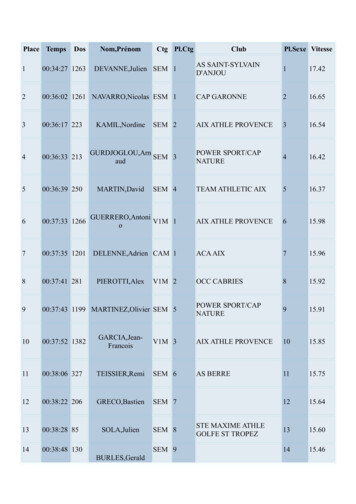

![[SEM] Structural Equation Modeling - Stata](/img/31/sem.jpg)
